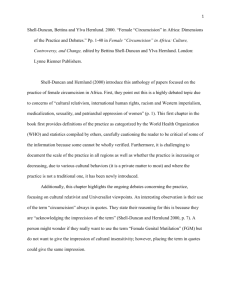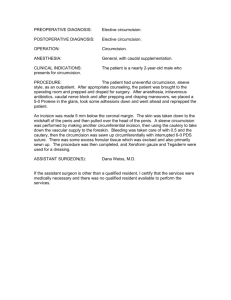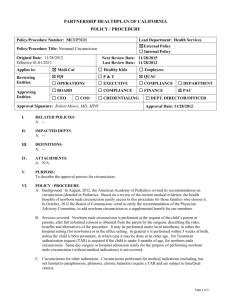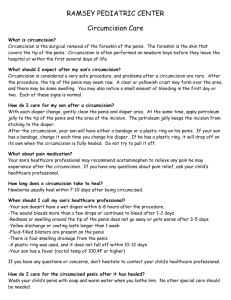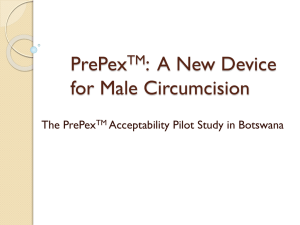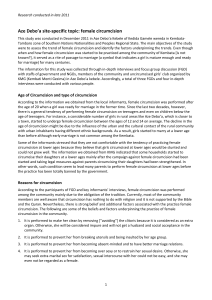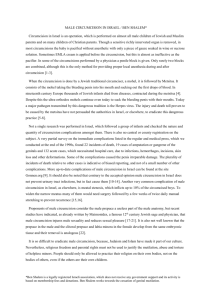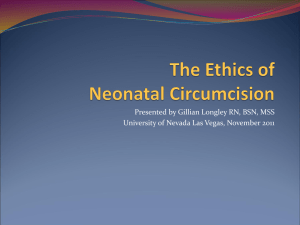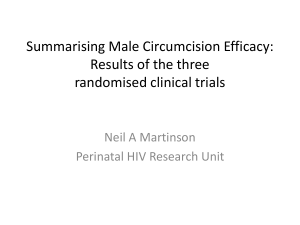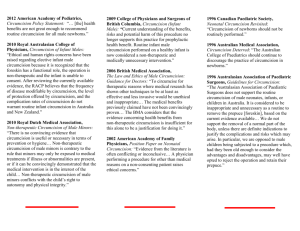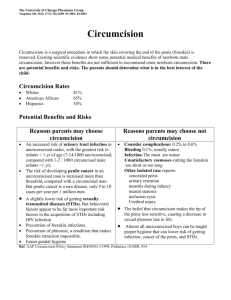Circumcision Guidelines
advertisement
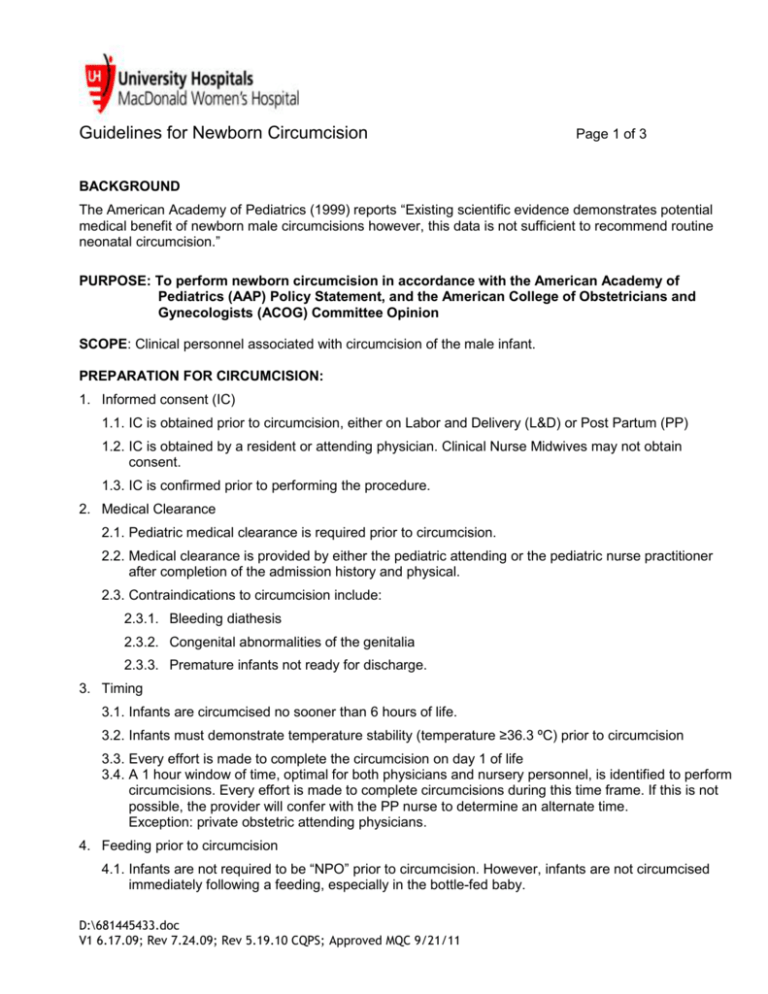
Guidelines for Newborn Circumcision Page 1 of 3 BACKGROUND The American Academy of Pediatrics (1999) reports “Existing scientific evidence demonstrates potential medical benefit of newborn male circumcisions however, this data is not sufficient to recommend routine neonatal circumcision.” PURPOSE: To perform newborn circumcision in accordance with the American Academy of Pediatrics (AAP) Policy Statement, and the American College of Obstetricians and Gynecologists (ACOG) Committee Opinion SCOPE: Clinical personnel associated with circumcision of the male infant. PREPARATION FOR CIRCUMCISION: 1. Informed consent (IC) 1.1. IC is obtained prior to circumcision, either on Labor and Delivery (L&D) or Post Partum (PP) 1.2. IC is obtained by a resident or attending physician. Clinical Nurse Midwives may not obtain consent. 1.3. IC is confirmed prior to performing the procedure. 2. Medical Clearance 2.1. Pediatric medical clearance is required prior to circumcision. 2.2. Medical clearance is provided by either the pediatric attending or the pediatric nurse practitioner after completion of the admission history and physical. 2.3. Contraindications to circumcision include: 2.3.1. Bleeding diathesis 2.3.2. Congenital abnormalities of the genitalia 2.3.3. Premature infants not ready for discharge. 3. Timing 3.1. Infants are circumcised no sooner than 6 hours of life. 3.2. Infants must demonstrate temperature stability (temperature ≥36.3 ºC) prior to circumcision 3.3. Every effort is made to complete the circumcision on day 1 of life 3.4. A 1 hour window of time, optimal for both physicians and nursery personnel, is identified to perform circumcisions. Every effort is made to complete circumcisions during this time frame. If this is not possible, the provider will confer with the PP nurse to determine an alternate time. Exception: private obstetric attending physicians. 4. Feeding prior to circumcision 4.1. Infants are not required to be “NPO” prior to circumcision. However, infants are not circumcised immediately following a feeding, especially in the bottle-fed baby. D:\681445433.doc V1 6.17.09; Rev 7.24.09; Rev 5.19.10 CQPS; Approved MQC 9/21/11 Guidelines for Newborn Circumcision Page 2 of 3 PROCEDURES FOR CIRCUMCISION 5. General 5.1. A registered nurse is present for circumcisions, pre-, peri-, and post-operatively 5.2. Standard universal protocol is followed prior to circumcision 5.3. No more than 2 babies are circumcised by the same Attending/Resident team at one time 5.4. When 2 circumcisions are occurring simultaneously, a distance of 3 feet is maintained between infants 6. Analgesia: 6.1. Analgesia is provided prior to circumcision. “Swaddling, oral sucrose, and acetaminophen may reduce stress response but are not sufficient for operative pain and are not recommended as the sole method of analgesia.” 6.2. Analgesia used for circumcision includes: 6.2.1. Eutectic Mixture of Local Anesthetics (EMLA cream) 6.2.2. Dorsal penile nerve block (see procedure sheet) 6.2.3. Ring block 6.2.4. Oral sucrose (Sweet-Ease®) 6.2.5. Acetaminophen 6.3. At least one full minute elapses after the placement of the nerve block and the commencement of the circumcision. 6.4. At least 45-60 minutes elapses after the placement of EMLA cream. 7. Circumcisions are performed using Gomco clamps, Mogen clamps, or Plastibells. 8. Post-Circumcision Care 8.1. The circumcision site is monitored carefully for bleeding following the procedure. 8.1.1. A cloth diaper is applied for approximately 2 hours following circumcision. 8.1.2. Bleeding is managed by applying direct pressure. 8.1.3. The physician is notified of bleeding that does not resolve after 5-10 minutes of direct pressure 8.1.4. The physician may apply a gelatin sponge (Gel Foam®) if pressure alone does not resolve the bleeding 8.1.5. If bleeding persists, dilute topical epinephrine solution or surgical repair may be required. The presence of an attending physician is required if either of these interventions is necessary. 8.2. The penis is wrapped in lubricated gauze immediately following the procedure. 8.3. The circumcision site is assessed approximately 2 hours following the procedure. 8.4. Vaseline is applied to the penis with every subsequent diaper change for 24-48 hours. D:\681445433.doc V1 6.17.09; Rev 7.24.09; Rev 5.19.10 CQPS; Approved MQC 9/21/11 Guidelines for Newborn Circumcision Page 3 of 3 8.5. Parents are provided homegoing instructions on care of the circumcision site prior to discharge. 9. Post-Circumcision Analgesia 9.1. Acetaminophen is administered round the clock for 24 hours following circumcision 9.2. Non-medicinal comfort measures: 9.2.1. Skin-to-skin contact (Kangaroo Care) 9.2.2. Infant feeding (breast or bottle) 9.2.3. Swaddling 9.2.4. Provision of a pacifier References Academy of Pediatrics, Committee on Fetus and Newborn, and The American College of Obstetricians and Gynecologists, Committee on Obstetric Practice. Guidelines for Perinatal Care. 6th ed. Evanston, IL, and Washington, DC: AAP and ACOG; 2007. Circumcision policy statement. Task Force on Circumcision. American Academy of Pediatrics. Pediatrics 1999; 103:686-693. Circumcision. ACOG Committee Opinion No. 260, American College of Obstetricians and Gynecologists. Obstet Gynecol 2001;98:707-708. Approved: MQC 09/21/11 D:\681445433.doc V1 6.17.09; Rev 7.24.09; Rev 5.19.10 CQPS; Approved MQC 9/21/11
